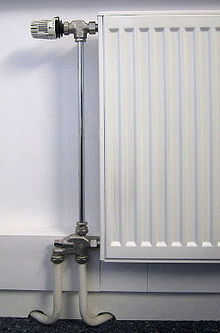One-pipe heating
A one- pipe heating system is a warm water heating system in which the radiators in a ring main flow through or are supplied with warm water one after the other .
In Germany there are an estimated 1.5 million single-pipe heating systems, both in single-family and multi-family houses. The majority was installed between 1975 and 1985.
Working principle
The water circulation is caused by a circulation pump , which overcomes all resistance in the heating water circuit due to the necessary pressure difference. In their simplest design as a one-pipe system with series connection, the radiators are flowed through one after the other without being able to be regulated. Improved one-pipe systems have branches to which the individual radiators are connected separately as a hydraulic parallel circuit and which can be regulated individually. For both types, the pipe can be routed both vertically and horizontally.
The thermal expansion of the water can be countered by an open expansion vessel or a closed membrane vessel. The progressive reduction in the heating water temperature on the radiators, which are located downstream in the order of flow, has to be countered with increasing radiator surface in order to cover the corresponding heat requirements of the rooms to be heated - the further away the radiator is from the boiler, the larger it has to be Be surface.
Advantages and disadvantages
Because of their low thermal inertia, single-pipe systems heat up quickly. In addition, because of their simple structure, they are cheaper to procure and lay the pipe network.
Because of the pump to be operated, there is a general dependency of the one-pipe heating on the power supply. In addition, malfunctions in a radiator affect the entire heating system. Another disadvantage is that the deliberate intervention in a radiator (e.g. shutdown processes) also affects all others.
Since the heating water constantly flows through all pipelines during the heating period, heat is constantly being given off during this period. If the selected flow temperature is too high, the entire heat demand of the building can be covered by the heat dissipation of the pipes. The heating can then no longer be sensibly regulated using thermostatic valves . Therefore, a clean hydraulic balance and a correct setting of the flow temperature are essential.
In heating systems with parallel connection (implemented as so-called bypasses) there is a permanent flow of heating water even if there is no heat consumption (closed radiator valves). This not only consumes pump power pointlessly, but also leads uncooled heating water from the flow into the return and thus reduces the spread of the water temperature, which u. a. leads to poorer heat consumption from the boiler.
Due to the high return temperature, modern heat generators such as condensing technology and heat pumps can usually not be used efficiently. Even self-regulating heating pumps cannot usually be used, since non-optimized single-pipe heating systems continuously require the maximum pump output.
Classic one-pipe heating systems have an additional thermal expenditure of around 20 percent and an additional electrical expenditure of around 70 percent compared to a two-pipe heating system. For an average single-family home, this results in additional costs for heating and electricity of around 350 euros per year.
Another problem arises with the heating cost billing in apartment buildings: In the apartments that are close to the heating, the heat emitted by the often uninsulated supply lines (with system-related high flow temperatures) is almost enough to heat the corresponding apartment. If heating costs are distributed solely by means of heating cost counters on the radiators, this inevitably leads to injustices.
Two-pipe heating
With two-pipe heating, which is mostly used today, two lines are laid to each radiator, one as an inlet to the heat consumers (flow) and one as a return line to the heat generator (return).
The disadvantage compared to single-pipe heating is naturally the longer cable length to be laid. This is offset by the essential advantage that the flow rate of the radiators is independent of one another and thus the same heating output can be achieved on each. This setting is made using control valves as part of hydraulic balancing .
The two lines can be laid in a star, ring or mixed form, depending on the arrangement of the rooms.
Variant of perpendicular heating
The perpendicular heating, also known as reverse single-pipe heating, is a fluidic variant of the single-pipe heating. This special form of single-pipe heating was mainly used in large systems in the past century, when z. B. low return temperatures were required in operation with district heating. The perpendicular heating achieves low return temperatures with a large spread between the flow and return.
In the case of reverse single-pipe heating, the direction of flow of the pipe network is reversed at regular intervals (e.g. every 30 minutes). The flow becomes the return, so to speak, and vice versa. As a result, all radiators receive the same heating medium temperatures over a period of time, whereby the fluctuations in the heating surface output are hardly noticed due to their inertia and the compensation of the radiator thermostats.
When designing the system components, it is important that the 4-way switch valve used at the beginning of the line have the shortest possible control time and the special thermostatic valves have the lowest possible flow resistance. In addition to the switching valve with interval switching, the system also includes an outside temperature-controlled flow temperature control and a return flow limiter.
literature
- Recknagel, Sprenger, Schramek: Pocket book for heating and air conditioning. 68th edition. R. Oldenbourg Verlag, Munich / Vienna 1997.
Web links
- Special topic single-pipe heating on Klima-sucht-Schutz.de
- bosy-online.de
Individual evidence
- ↑ a b One-pipe heating: Five questions to the experts - Prof. Hirschberg, FH Aachen . Klima-sucht-Schutz.de. Retrieved August 25, 2011.
- ↑ Explanation of the basics for a more equitable distribution of heating costs online (accessed on December 1, 2014)
